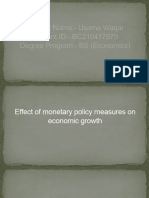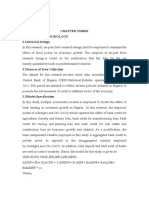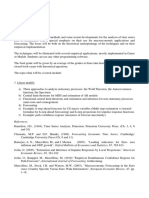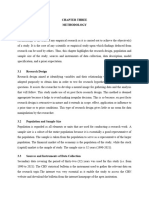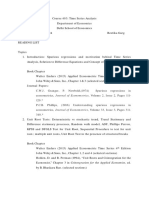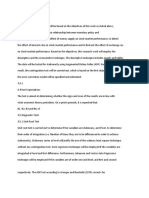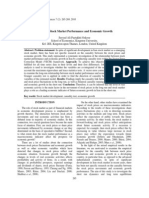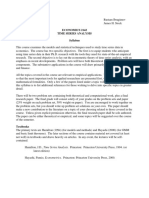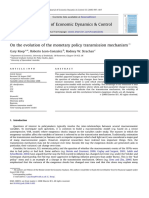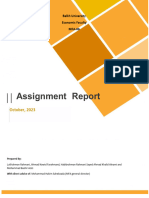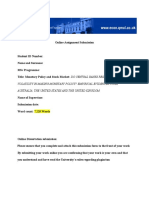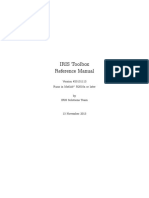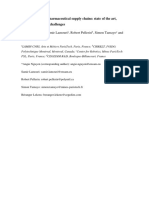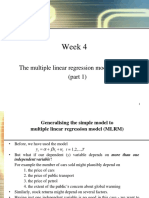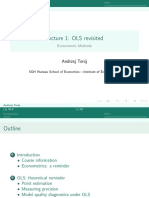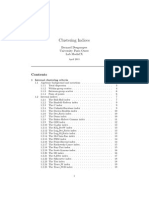3.
1 Information:
Time series data will be used for this study on the impact of monetary policy measures on economic
growth. Time series data refers to observations collected over a regular period of time, such as monthly
or quarterly data, for a specific set of variables. The data will include information on monetary policy
measures such as interest rates, money supply and other relevant policy indicators, as well as key
macroeconomic variables such as economic growth, investment, consumption and inflation.
3.2 Variables:
Dependent Variable: The dependent variable in this research is economic growth, usually measured by
metrics such as GDP growth rate, real per capita income, or real output. This shows the overall
expansion or contraction of the economy.
Independent Variables: Independent variables include various measures of monetary policy, such as
changes in interest rates (rate policy or key rates), the growth rate of the money supply, reserve
requirements, and other policy indicators. This variable captures central bank actions and interventions
and their potential effects on the economy.
Control variables: Control variables can be included in the account of other factors that can affect
economic growth, such as fiscal policy indicators (government spending, tax rates), exchange rates,
trade openness, and demographic variables. These control variables help isolate the specific effects of
monetary policy actions on economic growth.
3.3 Model Specifications:
The specification of the specific model used in a study will depend on the purpose of the research and
the nature of the data. General econometric models are used to analyze the relationship between
monetary policy measures and economic growth including Vector Autoregression (VAR), Autoregressive
Distributed Lag (ARDL), and Dynamic Stochastic General Equilibrium (DSGE) models. This model captures
the dynamic interaction between variables over time, allowing us to estimate the short- and long-term
effects of monetary policy on economic growth.
3.4 Procedure:
�The research methodology for this study will include time series analysis, which is a statistical technique
used to analyze patterns and relationships in time series data. Time series analysis includes several tools
and techniques:
Descriptive Statistics: Descriptive statistics will be used to summarize and describe the characteristics of
variables such as mean, standard deviation, and correlation coefficient.
Unit Root Test: A unit root test such as the Augmented Dickey-Fuller (ADF) test or the Phillips-Perron
(PP) test will be performed to assess the stationarity of the variables and ensure appropriate data
modeling.
Cointegration analysis: Cointegration analysis, such as Hansen's cointegration test, will be used to
investigate the long-run relationship between variables, particularly measures of monetary policy and
economic growth.
Estimation Method: Estimation methods such as Ordinary Least Squares (OLS) or Maximum Likelihood
Estimation (MLE) will be used to estimate the parameters of the econometric model and determine the
relationship between variables.
Diagnostic Tests: Diagnostic tests including autocorrelation, heteroscedasticity and serial correlation
tests will be conducted to ensure the reliability and validity of the proposed model.
3.5 Data Processing Tools:
The data processing instrument used in this research is EViews. EViews is a popular software package for
econometric analysis and time series modeling. It provides a user-friendly interface for data
management, statistical analysis, model estimation and forecasting. EViews allows you to efficiently
process data, estimate econometric models, and produce graphical results, making it ideal for time
series analysis needed in research projects.
Justification:
�The chosen methodology of time-lapse analysis is suitable for this research project because it allows to
investigate the relationship between monetary policy measures and economic growth over time. Time
series analysis allows us to identify patterns, trends, and dynamics in the data, helping to assess the
impact of monetary policy on economic growth. Using econometric models and statistical methods, this
study aims to provide empirical evidence on the causal relationship between monetary policy measures
and economic growth, while controlling for other factors that may affect monetary outcomes. Using
EViews as a data processing tool ensures efficient analysis and accurate interpretation of results.
